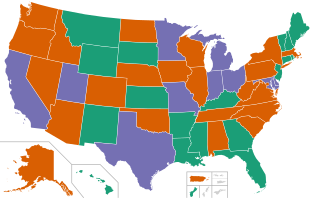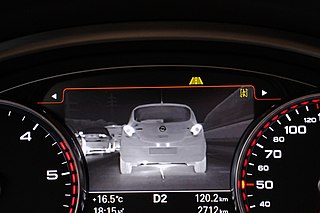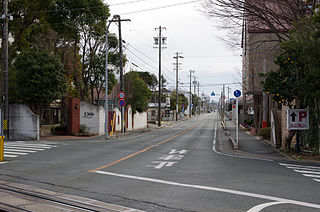Related Research Articles

Traffic comprises pedestrians, vehicles, ridden or herded animals, trains, and other conveyances that use public ways (roads) for travel and transportation.

An intersection or an at-grade junction is a junction where two or more roads converge, diverge, meet or cross at the same height, as opposed to an interchange, which uses bridges or tunnels to separate different roads. Major intersections are often delineated by gores and may be classified by road segments, traffic controls and lane design.

A pedestrian crossing is a place designated for pedestrians to cross a road, street or avenue. The term "pedestrian crossing" is also used in the Vienna and Geneva Conventions, both of which pertain to road signs and road traffic.

Traffic lights, traffic signals, or stoplights – also known as robots in South Africa – are signalling devices positioned at road intersections, pedestrian crossings, and other locations in order to control the flow of traffic.
Signal timing is the technique which traffic engineers use to distribute right-of-way at a signalized intersection. The process includes selecting appropriate values for timing, which are implemented in specialized traffic signal controllers. Signal timing involves deciding how much green time the traffic signal provides an intersection by movement or approach, how long the pedestrian WALK signal should be, whether trains or buses should be prioritized, and numerous other factors.

Emergency vehicle equipment is any equipment fitted to, or carried by, an emergency vehicle, other than the equipment that a standard non-emergency vehicle is fitted with.
Traffic signal preemption is a system that allows an operator to override the normal operation of traffic lights. The most common use of these systems manipulates traffic signals in the path of an emergency vehicle, halting conflicting traffic and allowing the emergency vehicle right-of-way, thereby reducing response times and enhancing traffic safety. Signal preemption can also be used on tram, light-rail and bus rapid transit systems, to allow public transportation priority access through intersections, and by railroad systems at crossings to prevent collisions.

In traffic engineering, there are regional and national variations in traffic light operation. This may be in the standard traffic light sequence or by the use of special signals.
A HAWK beacon is a traffic control device used to stop road traffic and allow pedestrians to cross safely. It is officially known as a pedestrian hybrid beacon. The purpose of a HAWK beacon is to allow protected pedestrian crossings, stopping vehicular traffic only as needed. The HAWK beacon is a type of traffic control alternative to traffic control signals and/or where an intersection does not meet traffic signal warrants.

The normal function of traffic lights requires more than sight control and coordination to ensure that traffic and pedestrians move as smoothly, and safely as possible. A variety of different control systems are used to accomplish this, ranging from simple clockwork mechanisms to sophisticated computerized control and coordination systems that self-adjust to minimize delay to people using the junction.

In the United States, road signs are, for the most part, standardized by federal regulations, most notably in the Manual on Uniform Traffic Control Devices (MUTCD) and its companion volume the Standard Highway Signs (SHS).

An automotive night vision system uses a thermographic camera to increase a driver's perception and seeing distance in darkness or poor weather beyond the reach of the vehicle's headlights. Such systems are offered as optional equipment on certain premium vehicles. The technology was first introduced in the year 2000 on the Cadillac Deville. This technology is based on the night vision devices (NVD), which generally denotes any electronically enhanced optical devices operate in three modes: image enhancement, thermal imaging, and active illumination. The automotive night vision system is a combination of NVDs such as infrared cameras, GPS, Lidar, and Radar, among others to sense and detect objects.

Stop and yield lines are transverse road surface markings that inform drivers where they should stop or yield when approaching an intersection. In some cases stop or yield lines are used in advance of mid-block crosswalks.

Matthew Henson State Park is a publicly owned greenway with recreational features that runs along Turkey Branch, a tributary of Rock Creek, in Montgomery County, Maryland. The state park is managed by Montgomery County under an agreement with the Maryland Department of Natural Resources. It was named for Maryland native and arctic explorer Matthew Henson.
Road traffic control devices are markers, signs and signal devices used to inform, guide and control traffic, including pedestrians, motor vehicle drivers and bicyclists. These devices are usually placed adjacent, over or along the highways, roads, traffic facilities and other public areas that require traffic control.
Road signs in Canada may conform to the Manual of Uniform Traffic Control Devices for Canada (MUTCDC) by the Transportation Association of Canada (TAC) for use by Canadian jurisdictions. Although it serves a similar role to the MUTCD from the US Federal Highway Administration, it has been independently developed and has a number of key differences with its American counterpart, most notably the inclusion of bilingual (English/French) signage for jurisdictions such as New Brunswick with significant anglophone and francophone population, and a heavier reliance on symbols rather than text legends.
Lightguard Systems is a California traffic safety device company known for developing “Smart Crosswalk”, the earliest pedestrian safety system to use embedded pavement flashing-light systems.
Designs of level crossings, where railway lines cross roads or other paths, vary country-to-country.
Traffic lights – devices positioned at road intersections, pedestrian crossings and other locations – control flows of traffic with social norms and laws created by the state. Traffic signals have to convey messages to drivers in a short period of time about constantly-changing road rules.

Crosswalks in the United States and Canada are normally found at intersections, though sometimes may be found mid-block. Crosswalk installations must follow the regulations specified in the Manual on Uniform Traffic Control Devices (MUTCD). At signalized intersections, crosswalks may have pedestrian signals which display symbols to mandate when pedestrians may cross the street.
References
- ↑ Eriksen, Olin (30 January 2007). "City Crosswalk System Out Of Order". Surf Santa Monica. Retrieved 5 July 2017.
- ↑ "Investigating Improvements to Pedestrian Crossings". FHWA.DOT.Gov. 1 June 2015. Retrieved 5 August 2017.
- ↑ "Are There Sensors At Traffic Lights?". elteccorp. 2019-12-26. Retrieved 2022-12-25.
- ↑ "Where and when LED flashing signs work best". carmanah. Jan 19, 2021. Retrieved Dec 25, 2022.
- ↑ Patella, Sergio (2020). "The effect of a LED lighting crosswalk on pedestrian safety: some experimental results". Safety. 6 (2): 20. doi: 10.3390/safety6020020 .